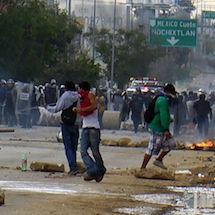
This is not just another of the many Oaxacan wars. It is part of a much more profound and extensive war that is by no means contained within the national territory itself. But the battle being waged in Oaxaca has a special meaning in that war, in the larger war.
![]()
This is not just another of the many Oaxacan wars. It is part of a much more profound and extensive war that is by no means contained within the national territory itself. But the battle being waged in Oaxaca has a special meaning in that war, in the larger war.
It is a battle long overdue. In Oaxaca people knew that many aspects of the ongoing confrontation were being postponed due to the elections. It was evident that after the elections, the attacks, provocations, and the final assault would intensify. Everywhere, preparations began.
All of Oaxaca was remembering the 14th of June. It was memory versus forgetting: today’s scenario seemed like a faithful mirror of 10 years ago. We watched the same movie: the teacher mobilizations, the encampment in the central plaza, the marches, the demands of the teachers, a fierce media campaign … And the authorities were betting again on the erosion of Section XXII, on the growing irritation of the citizens, betting on people’s fear of violence and the loss of jobs and income…
The march that arrived at the central plaza of Oaxaca on June 14th exemplified the experience. Over the course of almost ten hours, beside the teachers camping out in the square, very diverse sectors of society creatively expressed the ways in which memory inspires action today.
The Civil Space is a new manifestation of collectives, organizations and groups of very diverse characteristics that reclaim the experience of 2006 to give it new forms. Their pronouncement, “10 years constructing new paths,” was formulated in the context of government violence “for the purpose of imposing the misnamed educational reform” and also in the context of an exemplary teachers’ and popular resistance in the face of imminent risk that the repressive black night of repression that we lived on November 25, 2006 would be repeated.
Oaxacan civil society firmly pronounced the need to learn from 2006, “to end a cycle that left us full of injury and pain and to begin new stages of struggle where we do not make the same mistakes again and we apply the positive lessons of the movement.”
“Today, as various peoples are struggling in defense of their territory, against mining and wind-farms, struggling for respect for their autonomy and their usos y costumbres (indigenous self-governing practices), for their culture, for the protection of their natural resources, their forests, water and biodiversity… today we consider it necessary to advance in the construction of a common agenda that unifies teachers, neighborhoods, villages, young people, women, senior citizens, and all of us who aspire and are willing to struggle for a better Oaxaca and a better Mexico.”
In organizing a “Day of Reflection 2006-2016”, the Civil Space made a call to strengthen the teachers’ movement and the struggles faced in neighborhoods, rural communities and small towns to bring down the labor reform disguised as “educational reform” and structural reforms and to bring an end to repression. Only together, it was emphasized, “will we achieve freedom for our political prisoners, have our disappeared returned alive, and that the long night of oppression and pain against the teachers and the people of Oaxaca does not repeat itself.”
Since that day, they began to blockade the roads. In Nochixtlán and in the Isthmus, the people went out into the streets to block the trucks filled with militarized police that headed to Oaxaca City, from whose airport they had begun to arrive. Many thousands of people, of all sectors of society, fed and supported the blockades and began to weave networks of solidarity.
Saturday afternoon, the Tepeyac Center for Human Rights, from the Isthmus of Tehuantepec, and the Network of Community Defenders of the Peoples of Oaxaca published a communiqué in which they declared the federal government’s response to the protests to be absurd and meaningless. They suggested that the escalation of violence exposes a political class that seeks to perpetuate itself “in the logic of power and confrontation, instead of fostering spaces for dialogue that open viable channels for this fractured democracy.” At the same time, they valued the wisdom of women and men of the villages, collectives and emerging groups, as they “propose a creative resistance, analyzing the meaning of life and the construction of a just society.”
Oaxaca is burning. There is a clear consciousness of this moment of danger. Therefore, from every corner, we appeal today to the anger that expresses the moral indignation that a growing number of people share, as well as that which stands for bravery, integrity, and the ability to walk with dignity and clarity in these dark times. The battle has just begun.
Gustavo Esteva
